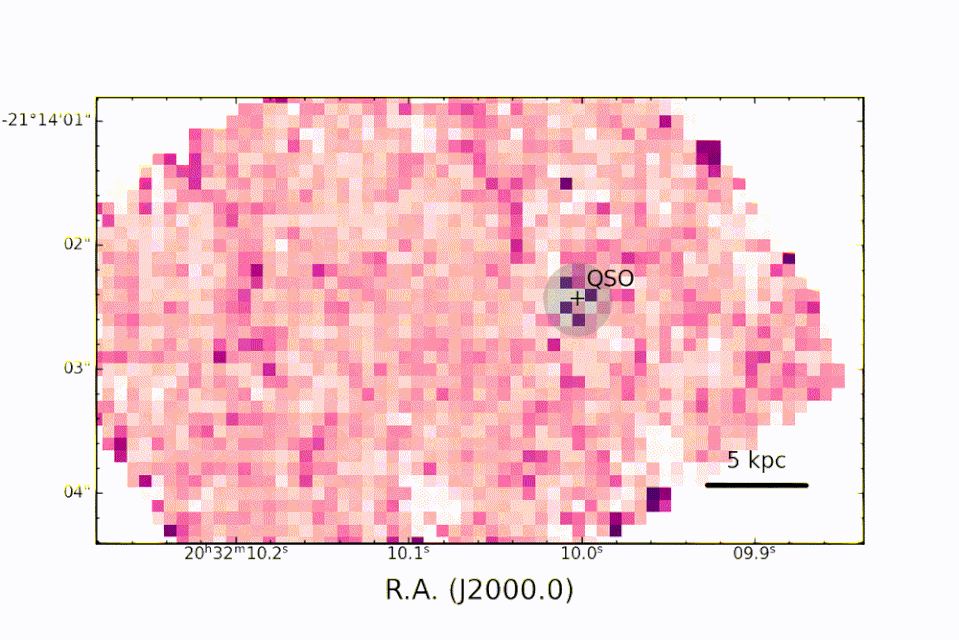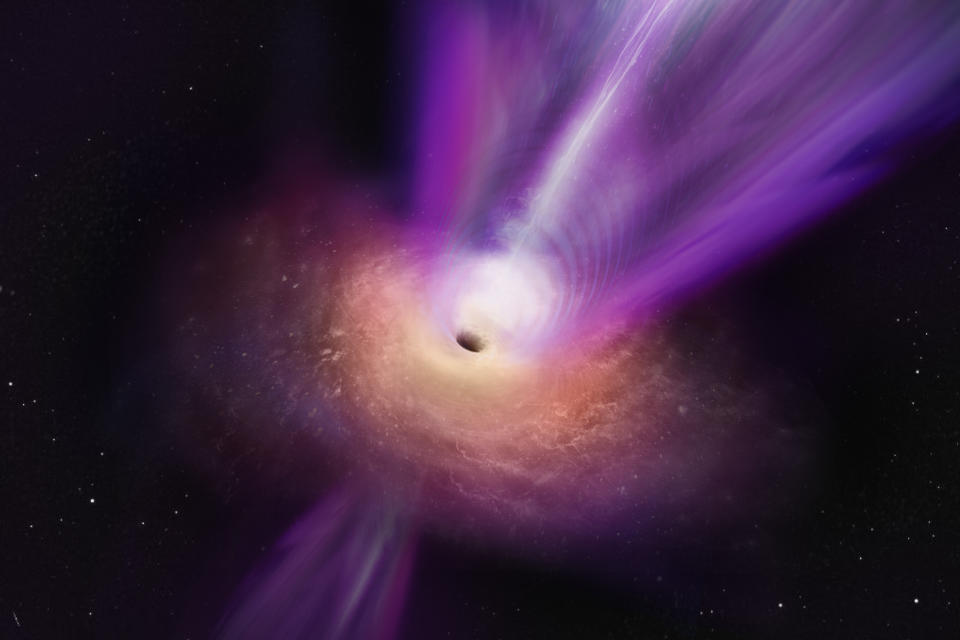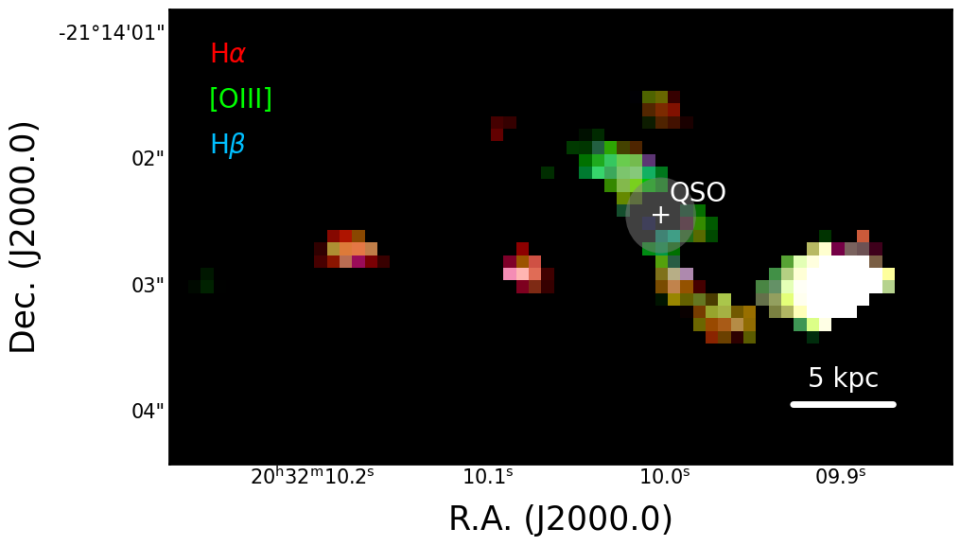Astronomers using the James Webb Space Telescope (JWST) have observed the dramatic “dance” between a supermassive black hole and two satellite galaxies. The observations could help scientists better understand how galaxies and supermassive black holes grew in the early universe.
This particular supermassive black hole feeds off of its surrounding matter, powering a bright quasar that is so far away that JWST saw it less than a billion years after the Big Bang. The quasar, called PJ308-21, is located in an active galactic nucleus (AGN) in a galaxy that is in the process of merging with two larger satellite galaxies.
Not only did the team determine that the black hole had a mass equal to two billion solar masses, they also found that both the quasar and the galaxies involved in the merger were highly evolved—a surprising finding considering that the cosmos was still a baby, with 13.8 years of age remaining.
The merger of these three galaxies is likely to bring large amounts of gas and dust to the supermassive black hole, facilitating its growth and allowing it to continue powering PJ308-21.
Relating to: James Webb Space Telescope finds ‘extreme red’ supermassive black hole growing in early universe
“Our study shows that both central high-redshift black holes [early and distant] “Quasars and their host galaxies have undergone an extremely productive and turbulent growth during the first billion years of cosmic history, aided by the rich galactic environment in which these sources formed,” Roberto Decarli, researcher and team leader at Italy’s National Institute of Astrophysics (INAF), said in a statement.
The data was collected by JWST’s Near Infrared Spectrograph (NIRSpec) instrument in September 2022 as part of the 1554 Program, which aims to observe the merger between the host galaxy PJ308-21 and two of its satellite galaxies.
Decarli added that the work created a real “emotional rollercoaster” for the team, as they developed innovative solutions to overcome initial challenges in data reduction and produce images with less than 1 percent uncertainty per pixel.

A multi-metal quasar
Quasars are born when supermassive black holes, with masses millions or billions of times that of the sun, at the hearts of galaxies are surrounded by a wealth of gas and dust. This material forms a flattened cloud called an accretion disk that orbits the black hole and gradually feeds it.
The black hole’s immense gravitational pull produces powerful tidal forces in this accretion disk, heating the gas and dust to temperatures of 120,000 degrees Fahrenheit (67,000 degrees Celsius). This causes the accretion disk to emit light across the electromagnetic spectrum. This emission can often be brighter than the combined light of every star in the surrounding galaxy, making quasars like PJ308-21 some of the brightest objects in the universe.
While black holes do not have properties that can be used to determine how evolved they are, accretion disks (and therefore quasars) do. In fact, galaxies can be “aged” in the same way.


The early universe was filled with hydrogen, the lightest and simplest element, and some helium. This formed the basis of the first stars and galaxies, but over the lifetime of these stellar bodies, they formed elements heavier than hydrogen and helium, which astronomers call “metals.”
When these stars ended their lives in massive supernova explosions, these metals were dispersed throughout their galaxies and became the building blocks for the next generation of stars. This process caused the stars, and through them the galaxies, to become increasingly “metal-rich.”
The team found that, like most AGNs, PJ308-21’s active heart is rich in metals, and the gas and dust around it are “photoionized.” This is the process by which particles of light called photons provide the energy that electrons need to escape from atoms, creating electrically charged ions.


One of the galaxies merging with its host galaxy, PJ308-21, is also metal-rich, and the matter within it is also partially photoionized by electromagnetic radiation from the quasar.
Photoionization also occurs in the second satellite galaxy, but in this case it is caused by a rapid wave of star formation. This second galaxy also differs from the first and the AGN in that it appears to be metal-poor.
“Thanks to NIRSpec, for the first time we can examine the optical band in the PJ308-21 system, which is rich in valuable diagnostic data on the properties of the gas near the black hole in the galaxy hosting the quasar and the surrounding galaxies,” said team member and INAF astrophysicist Federica Loiacono. “For example, we can see the emission from hydrogen atoms and compare this with the emission from chemical elements produced by stars to determine how rich the gas is in metals.”
RELATED STORIES:
— The supermassive black hole of the galaxy M87 is shooting out jets at speeds close to the speed of light
— Brightest quasar ever seen is powered by a black hole that ‘eats a sun a day’
— First human-imaged black hole has twisted magnetic fields, and scientists are excited
Although light from this quasar in the early universe comes across a wide range of the electromagnetic spectrum, including optical light and X-rays, the only way to observe it is in infrared.
This is because the expansion of the universe has “stretched” the wavelengths significantly, as the light has traveled over 12 billion years to reach JWST. This “shifts” the light towards the “red end” of the electromagnetic spectrum, a phenomenon understandably called “redshift” and denoted by astronomers as “z”.
JWST is adept at seeing “high redshift” or “high-z” objects and events, such as PJ308-21, because of its sensitivity to infrared light.
“Thanks to the near- and mid-infrared sensitivity of JWST, it has been possible to study the spectra of quasars and companion galaxies in the distant Universe with unprecedented precision,” concluded Loiacono. “Only the excellent ‘image’ provided by JWST can guarantee these observations.”
The team’s research has been accepted for publication in the journal Astronomy & Astrophysics in June 2024.